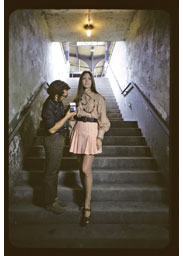 Spider Martin’s Unseen Sixties reveals a side of the nationally known photographer that many didn’t know existed. Best known for his Civil Rights era photographs, Martin was a prolific photographer with an extensive and varied portfolio. In addition to his freelance work with McCall’s and other national magazines (some of which is featured in the current show), Martin also spent time working at both The Birmingham News and Birmingham Magazine as a contributing photographer.
Spider Martin’s Unseen Sixties reveals a side of the nationally known photographer that many didn’t know existed. Best known for his Civil Rights era photographs, Martin was a prolific photographer with an extensive and varied portfolio. In addition to his freelance work with McCall’s and other national magazines (some of which is featured in the current show), Martin also spent time working at both The Birmingham News and Birmingham Magazine as a contributing photographer.
It was during Martin’s time as a photojournalist for The Birmingham News that he took his now famous photographs of events taking place during the civil rights movement. Weaving in and out of the crowd, Martin captured the faces and events of that turbulent period with skill and artistry. Many of the images were sent out on the wire, better received in other states than they were in his home city. Martin later became a freelancer, doing commercial photography for McCall’s, Women’s Wear Daily and even Playboy.
In the late seventies Ray Martin, Spider’s brother, became managing editor at Birmingham Magazine and asked his brother to come on board, too. “We had no money, so all we had to offer him was the exposure of a byline and space.” That space was almost half of the thirteenth floor, which Martin used rent-free in exchange for doing all of the photography for the magazine. Ray says that Martin “was very open to the idea and excited about [getting the] studio space. He was never rich or well-off money wise, so he was always looking to work a deal.”
Elaine Hobson Miller, staff writer at Birmingham Magazine from 1978-1980, remembers talking to Martin about his chosen profession. “I asked him once what made him get into photography. He said that he wanted to be an artist and somewhere along the line he figured out it was quicker to take a picture than to paint one.”
Martin worked with Birmingham Magazine from the late seventies throughout the eighties. During that time he took photographs on wide-ranging subjects – from fashion shoots to portraits of prominent Birmingham businessmen and, once, photographs of rural Guatemala for an issue on Birmingham’s social and economic ties with that country. His then teenage daughter, Tracy Martin, also has photo credits in that issue.
When it came time to prepare an exhibit to celebrate the 40th anniversary of the “Summer of Love,” exhibit co-curators Brett Levine and Mindi Shapiro approached Tracy with the idea of showcasing some of her late father’s lesser known work. There were hundreds of images in Spider’s archives to go through, and the three chose fashion images that seemed to both represent the sixties era and showcase Martin’s artistic vision. Many of the selected pieces originally appeared in Birmingham Magazine, as well as advertisements for Avondale Mills. The work features known models Lynn Spottswood and Brenda Martin, his first wife, as well as models whose names have been lost over time. There’s even a photograph of Martin himself as the fashion photographer going about his job. The images on display are printed from his original Kodachrome transparencies.
Levine, the director for the UAB Visual Arts Gallery, has been very pleased with the attendance for this show. “This exhibit has drawn in a lot of families with adult children who come in to look at the images from the time when they were growing up. And the children, in their late teens and early twenties, seem to be interested in the retro aspect of the show.” Levine said that though the total attendance is not yet known, he believes the exhibit has drawn a larger than usual crowd, especially for a summer show. This positive reception, along with the extensive and varied collection of work that exists, may lead to future exhibitions of Martin’s photography or, potentially, some sort of publication of his work by the university.
Spider Martin’s Unseen Sixties can be seen through Friday, August 17th at the UAB Visual Arts Gallery, 900 13th St. South. The Gallery is open from 11 a.m.-5 p.m. Monday-Thursday and 11 a.m.-4 p.m. on Friday. Click here for a narrated preview of some of the works on display at the UAB Visual Arts Gallery.







